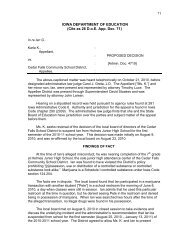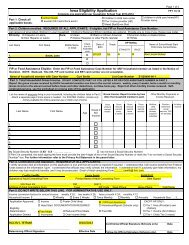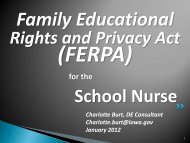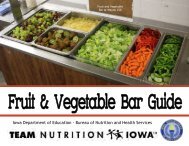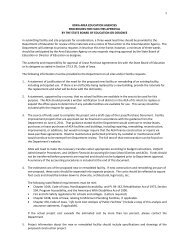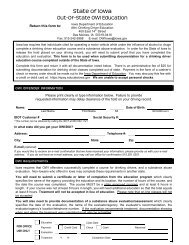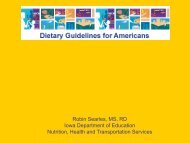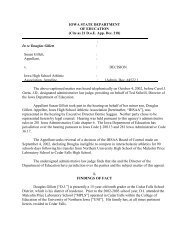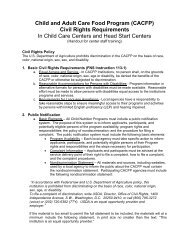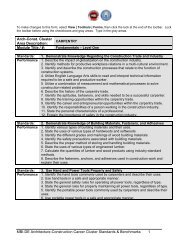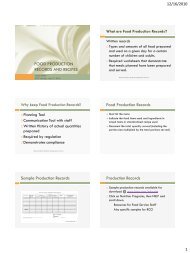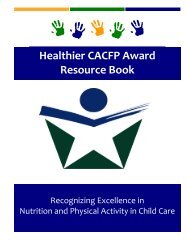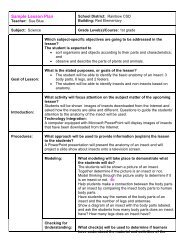Model Evidence for Iowa Teaching Standards and Criteria
Model Evidence for Iowa Teaching Standards and Criteria
Model Evidence for Iowa Teaching Standards and Criteria
Create successful ePaper yourself
Turn your PDF publications into a flip-book with our unique Google optimized e-Paper software.
<strong>Model</strong> <strong>Evidence</strong> <strong>for</strong> <strong>Iowa</strong> <strong>Teaching</strong> <strong>St<strong>and</strong>ards</strong> <strong>and</strong> <strong>Criteria</strong>Examples<strong>Evidence</strong> is not needed <strong>for</strong> each of the 42 criteria. It is the presence of qualityevidence under a st<strong>and</strong>ard that determines if a teacher meets that particular <strong>Iowa</strong><strong>Teaching</strong> St<strong>and</strong>ard. This is determined by a qualified, <strong>Iowa</strong> trained evaluator, theconversation around these pieces of evidence by the evaluator <strong>and</strong> the teacher, <strong>and</strong>the district guidelines <strong>for</strong> evaluation. <strong>Evidence</strong> used to show competence in onest<strong>and</strong>ard <strong>and</strong> criteria can <strong>and</strong> should be used <strong>for</strong> showing competence in otherst<strong>and</strong>ards <strong>and</strong> criteria. The conversation between the evaluator <strong>and</strong> teacher is vitalin this determination.There is no requirement by the State of <strong>Iowa</strong> that 42 different pieces of evidence<strong>for</strong> a teacher (beginning or career) must be produced to meet the <strong>Iowa</strong> <strong>Teaching</strong><strong>St<strong>and</strong>ards</strong>.There is no requirement by the State of <strong>Iowa</strong> that teachers (beginning or career)must create a portfolio of evidence. It is each district’s responsibility to determinehow the evidence will be organized <strong>and</strong> if certain pieces of evidence are required<strong>for</strong> the district’s teachers.The term observation notes used in this chart refer to evaluator observation of theteacher’s behavior. The interpretation of the evidence in classroom observationswill depend on the conversation between evaluator <strong>and</strong> teacher.See the Excel document <strong>for</strong> an example of how to organize evidence <strong>for</strong> meetingthe st<strong>and</strong>ards. You will also see an example of evidence which does meet severalst<strong>and</strong>ards <strong>and</strong> criteria.
<strong>Iowa</strong> <strong>Teaching</strong> <strong>St<strong>and</strong>ards</strong>St<strong>and</strong>ard 1 - Demonstrates ability to enhance academic per<strong>for</strong>mance <strong>and</strong> support <strong>for</strong> implementation ofthe school district's student achievement goals.<strong>Model</strong> <strong>Evidence</strong> <strong>Criteria</strong>: The teacher Suggestions <strong>for</strong> CrossReference of Multiple<strong>St<strong>and</strong>ards</strong> <strong>and</strong> <strong>Criteria</strong>• Grade book entries/classroomdata• Copy of mid-term report• Rubrics• Report card• Letters/e-mails home• Work of students displayed• Student portfolio• Class newsletters• Follows CSIP/SIP/IEP• Observation notes• Individual ProfessionalDevelopment Plan• Volunteer <strong>for</strong> committees• Creates lessons to meetcurriculum st<strong>and</strong>ards• Class test results• Lesson plans• Team meeting minutes• Differentiated lessons• Use of IEP results• Running Records/other datagathering evidence• Show concurrent lesson plans• Modification/accommodationplans• Multiple assessments• Survey results fromstudents/parents• Class rules/expectations posted• Community building Activitiesobservationnotes• Bulletin boards• Lesson Plansa. Provides evidence of studentlearning to students, families, <strong>and</strong>staff.b. Implements strategiessupporting student, building, <strong>and</strong>district goals.c. Uses student per<strong>for</strong>mance dataas a guide <strong>for</strong> decision-making.d. Accepts <strong>and</strong> demonstratesresponsibility <strong>for</strong> creating aclassroom culture that supports thelearning of every student.e. Creates an environment ofmutual respect, rapport, <strong>and</strong>fairness.1g, 5a,b,d,e 8e4a, 7a,b,c,d 8c3a 4a,c 5a,f2b, 3a,b,c 4c 6a,b,c.d.e 8d3d, 4c,d 6a,e
• Action steps/teacher action• Notes from child study/problemsolving/instructional decisionmaking meetings• E-mail examples• Classroom newsletter• Phone call log• Thank you notes receivedf. Participates in <strong>and</strong> contributes toa school culture that focuses onimproved student learning.g. Communicates with students,families, colleagues, <strong>and</strong>communities effectively <strong>and</strong>accurately.1b,f, 4b 5f 7a1a, 5a,b,d,e 8eSt<strong>and</strong>ard 2 - Demonstrates competence in content knowledge appropriate to the teaching position.<strong>Model</strong> <strong>Evidence</strong> <strong>Criteria</strong>: The teacher Suggestions <strong>for</strong> CrossReference of Multiple<strong>St<strong>and</strong>ards</strong> <strong>and</strong> <strong>Criteria</strong>• Copies of lesson plan• Student work/portfolio• Observation notes• Copies of h<strong>and</strong>-outs• Videos used, CD's• Notes on lesson plans• Log of AEA involvement• Observation notes• Lesson plans• Notes planning meetings• Observation notes• Assessments• Evaluator observation notes• Lesson Plans• Differentiated student worksamplesa. Underst<strong>and</strong>s <strong>and</strong> uses keyconcepts, underlying themes,relationships, <strong>and</strong> differentperspectives related to the contentarea.b. Uses knowledge of studentdevelopment to make learningexperiences in the content areameaningful <strong>and</strong> accessible <strong>for</strong>every studentc. Relates ideas <strong>and</strong> in<strong>for</strong>mationwithin <strong>and</strong> across content areas.d. Underst<strong>and</strong>s <strong>and</strong> usesinstructional strategies that areappropriate to the content area2c 3a2d 3c 4c3a 4a3b.c.f
St<strong>and</strong>ard 3 - Demonstrates competence in planning <strong>and</strong> preparing <strong>for</strong> instruction.<strong>Model</strong> <strong>Evidence</strong> <strong>Criteria</strong>: The teacher Suggestions <strong>for</strong> CrossReference of Multiple<strong>St<strong>and</strong>ards</strong> <strong>and</strong> <strong>Criteria</strong>• Copies of assessments includingpre-assessments• Lesson plans that fit districtst<strong>and</strong>ards• Graphs showing variety ofassessment results <strong>and</strong> plans <strong>for</strong>using assessment data• H<strong>and</strong>books, h<strong>and</strong>-outs• Lesson plans reflectingteaching/rein<strong>for</strong>cing expectations• Photos of student successes• Survey results of studentresponses to classroom climate• Observation notes• Student interest surveys• Parent surveys• Lesson plans• Variety of project choices <strong>for</strong> alesson• The use of teaching techniques:cooperative learning, projects,presentations, etc-observable• Copies of lesson plans reflectingdifferentiation of instruction• Student evaluation of completedproject• Photos of students engaged inlearning activities• Observation notes• Computer lab use-observable• Copies of technology-basedlesson plans• Observation notes• Bibliography of resources used inplanning• Photo documentation• Field Trip summaries• Community speakers utilizedobservablea. Utilizes student achievementdata, local st<strong>and</strong>ards, <strong>and</strong> thedistrict curriculum in planning <strong>for</strong>instruction.b. Sets <strong>and</strong> communicates highexpectations <strong>for</strong> social, behavioral,<strong>and</strong> academic success of allstudents.c. Uses students' developmentalneeds, background, <strong>and</strong> interests inplanning <strong>for</strong> instruction.d. Selects strategies to engage allstudents in learning.e. Uses available resources,including technologies, in thedevelopment <strong>and</strong> sequencing ofinstruction.1c, 2c 3a1a,d,e,f 5b,d 6a,b,c 8d2b 3d 4b,c1b 2d 3d, 4b,c,d,f2d 3e 4d
St<strong>and</strong>ard 4 - Uses strategies to deliver instruction that meet the multiple learning needs of students.<strong>Model</strong> <strong>Evidence</strong> <strong>Criteria</strong>: The teacher Suggestions <strong>for</strong> CrossReference of Multiple<strong>St<strong>and</strong>ards</strong> <strong>and</strong> <strong>Criteria</strong>• Lesson plans• Assessments results-both teacherdeveloped <strong>and</strong> textbook• Photo diary/documentation• Notes from team planningsessions• <strong>St<strong>and</strong>ards</strong>/benchmarks posted inroom• Observation notes• Examples of student work• Examples of research reviewed<strong>and</strong> used• Teacher self-assessment• Workshop implementation, logs<strong>and</strong> evaluator observation notes• Lesson plans• Use of accommodation <strong>and</strong>modifications - observable• Copy of instructional decisionmaking plans• Student work showing evidenceof positive results• 504, IEP accommodation plans• Student work samples• Photos of students engaged intheir work• Surveys results from students• Lesson plans• Observation notes• Student interview data• Providing social activities• Parent input about student• Student work samples Lessonswith choices <strong>for</strong> students• Guest speakers• Lesson plans• Student research projects usingvariety of presentation <strong>for</strong>mats -observable• Web site developed by teachera. Aligns classroom instructionwith local st<strong>and</strong>ards <strong>and</strong> districtcurriculum.b. Uses research-basedinstructional strategies that addressthe full range of cognitive levels.c. Demonstrates flexibility <strong>and</strong>responsiveness in adjustinginstruction to meet student needs.d. Engages students in variedexperiences that meet diverseneeds <strong>and</strong> promote social,emotional, <strong>and</strong> academic growth.e. Connects students' priorknowledge, life experiences, <strong>and</strong>interests in the instructionalprocess.f. Uses available resources,including technologies, in thedelivery of instruction.1b 2c 3a 8c1b 3d 7a1c 2b 3a,c 4b,d,f 5f2b 3d 4c,f2c 3c,d 4c,d2d, 3d,e
St<strong>and</strong>ard 5 – Uses a variety of methods to monitor student learning.<strong>Model</strong> <strong>Evidence</strong> <strong>Criteria</strong>: The teacher Suggestions <strong>for</strong> CrossReference of Multiple<strong>St<strong>and</strong>ards</strong> <strong>and</strong> <strong>Criteria</strong>• Assessment results reflected inlesson plans• Copies of alternative testsa. Aligns classroom assessmentwith instruction.3a4c 5c• Newsletter• Classroom website• Report cards• Parent Info night• Parent conferencesb. Communicates assessmentcriteria <strong>and</strong> st<strong>and</strong>ards to allstudents <strong>and</strong> parents.1g3b,e• <strong>Evidence</strong> of multiple assessmentsthroughout the year• Lesson plans reflectingassessment results• Goal charts• Goal sheets written by students• Achievement data• Lesson plans showing reflectivewriting <strong>for</strong> studentsc. Underst<strong>and</strong>s <strong>and</strong> uses the resultsof multiple assessments to guideplanning <strong>and</strong> instruction.d. Guides students in goal setting<strong>and</strong> assessing their own learning.1c 3a 4c1c 6a 8e• Conferences• IEP meetings• Parent phone calls loge. Provides substantive, timely, <strong>and</strong>constructive feedback to students<strong>and</strong> parents.1g3b,e• Notes from team meetings• Child study team/ problemsolving <strong>and</strong>/or instructionaldecision making notes• Team meeting notes• Evaluator observation of teammeetingsf. Works with other staff <strong>and</strong>building <strong>and</strong> district leadership inanalysis of student progress.1f 7a,b 8c,e
St<strong>and</strong>ard 6 - Demonstrates competence in classroom management.<strong>Model</strong> <strong>Evidence</strong> <strong>Criteria</strong>: The teacher Suggestions <strong>for</strong> CrossReference of Multiple<strong>St<strong>and</strong>ards</strong> <strong>and</strong> <strong>Criteria</strong>• Cooperative learning strategiesobservable• Classroom set-up/arrangementobservable• Small-group activities-observable• Seating chart• Student jobs in groupsobservable• Student self-evaluation ofbehavior• Expectations posted in classroom• My job/your job chart posted• Photos of agreements posted• Rules/expectations posted• Classroom agenda/calendarposted• Class contract/constitution posted• Elements of first three observable• Substitute folder available• Students on-task-observable• Smooth transitions-observable• Observation notesa. Creates a learning communitythat encourages positive socialinteraction, active engagement, <strong>and</strong>self-regulation <strong>for</strong> every student.b. Establishes, communicates,models, <strong>and</strong> maintains st<strong>and</strong>ards ofresponsible student behavior.c. Develops <strong>and</strong> implementsclassroom procedures <strong>and</strong> routinesthat support high expectations <strong>for</strong>learning.d. Uses instructional timeeffectively to maximize studentachievement.1d,e 3b 5d 6d1d,e 6a,c,d,e 8d1d,e 3b 6a,b,d,e3d• Student behavior-observable• Charts such as my job/your jobpostede. Creates a safe <strong>and</strong> purposefullearning environment.1d,f6a,c
St<strong>and</strong>ard 7 - Engages in professional growth.<strong>Model</strong> <strong>Evidence</strong> <strong>Criteria</strong>: The teacher Suggestions <strong>for</strong> CrossReference of Multiple<strong>St<strong>and</strong>ards</strong> <strong>and</strong> <strong>Criteria</strong>• Transcripts• Copies of membershipcertificates• Log of Books/journals read• Degrees or certification• Documentation of professionallearninga. Demonstrates habits <strong>and</strong> skills ofcontinuous inquiry <strong>and</strong> learning.7b,c,d• Lesson plans showing coteaching• Peer evaluation• Evaluator observation of coteachingb. Works collaboratively toimprove professional practice <strong>and</strong>student learning.5f8c,d,e• Innovative research-basedlessons – observation notes• Presentation of knowledge togroups• Teacher journal entries showingreflective teachingc. Applies research, knowledge,<strong>and</strong> skills from professionaldevelopment opportunities toimprove practice.2d 4b 7a,d• Show growth in studentachievement• Individual professionaldevelopment plans• Observation notes from evaluatord. Establishes <strong>and</strong> implementsprofessional development plansbased upon the teacher needsaligned to the <strong>Iowa</strong> <strong>Teaching</strong><strong>St<strong>and</strong>ards</strong> <strong>and</strong> district/buildingstudent achievement goals.1b8a,b,c
St<strong>and</strong>ard 8 - Fulfills professional responsibilities established by the school district.<strong>Model</strong> <strong>Evidence</strong> <strong>Criteria</strong>: The teacher Suggestions <strong>for</strong> CrossReference of Multiple<strong>St<strong>and</strong>ards</strong> <strong>and</strong> <strong>Criteria</strong>• Show growth in studentachievement• Teacher evaluation results• Individual professionaldevelopment plan• Evaluator observable notes• Documentation of m<strong>and</strong>atorytraining• Committee documentation ofmembership• District committee/activitydocumentation• <strong>Evidence</strong> of team playerobservable• Participates in staff functions• Student work samples• Observation notesa. Adheres to board policies,district procedures, <strong>and</strong> contractualobligations.b. Demonstrates professional <strong>and</strong>ethical conduct as defined by statelaw <strong>and</strong> individual district policy.c. Contributes to ef<strong>for</strong>ts to achievedistrict <strong>and</strong> building goals.d. Demonstrates an underst<strong>and</strong>ingof <strong>and</strong> respect <strong>for</strong> all learners <strong>and</strong>staff.8b8a1f 5f 7b6e• Phone log of parent contact• E-mail log of parent contacts• Conference schedule• Community speakers/guests• Field tripe. Collaborates with students,families, colleagues, <strong>and</strong>communities to enhance studentlearning.1f5d,f




